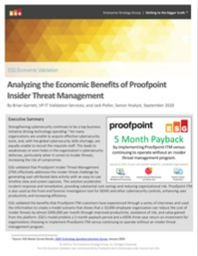Analyzing the Economic Benefits of Proofpoint Insider Threat Management
Strengthening cybersecurity continues to be a top business initiative driving technology spending. Yet many organisations are unable to acquire effective cybersecurity tools, and, with the global cybersecurity skills shortage, are equally unable to recruit the requisite staff. This leads to weaknesses or even holes in the organisation's cybersecurity defenses, particularly when it comes to insider threats, increasing the risk of compromise.
ESG validated that Proofpoint Insider Threat Management (ITM) effectively addresses the insider threat challenge by generating user-attributed data activity with an easy-to-use timeline view and screen captures. The solution accelerates incident response and remediation, providing substantial cost savings and reducing organisational risk. Proofpoint ITM is also used as the front-end forensic investigation tool for SIEMS and other cybersecurity controls, enhancing user productivity and increasing efficiency.
Read More
By submitting this form you agree to Proofpoint contacting you with marketing-related emails or by telephone. You may unsubscribe at any time. Proofpoint web sites and communications are subject to their Privacy Notice.
By requesting this resource you agree to our terms of use. All data is protected by our Privacy Notice. If you have any further questions please email dataprotection@techpublishhub.com
Related Categories: Applications, Cloud, Collaboration, Compliance, Digital transformation, Email, ERP, Network, SaaS, SAN, Server, Storage


More resources from Proofpoint

Getting Started with DMARC
Email fraud costs companies around the world billions and can destroy brand reputation and consumer trust in minutes.
The DMARC (Domain-based...

Analyzing the Economic Benefits of Proofpoint...
Strengthening cybersecurity continues to be a top business initiative driving technology spending. Yet many organisations are unable to acquire eff...

Driving Real Behaviour Change
Today's most potent cyber threat isn't a zero-day vulnerability, new malware or the latest exploit kit. It's your own users. That's because today's...